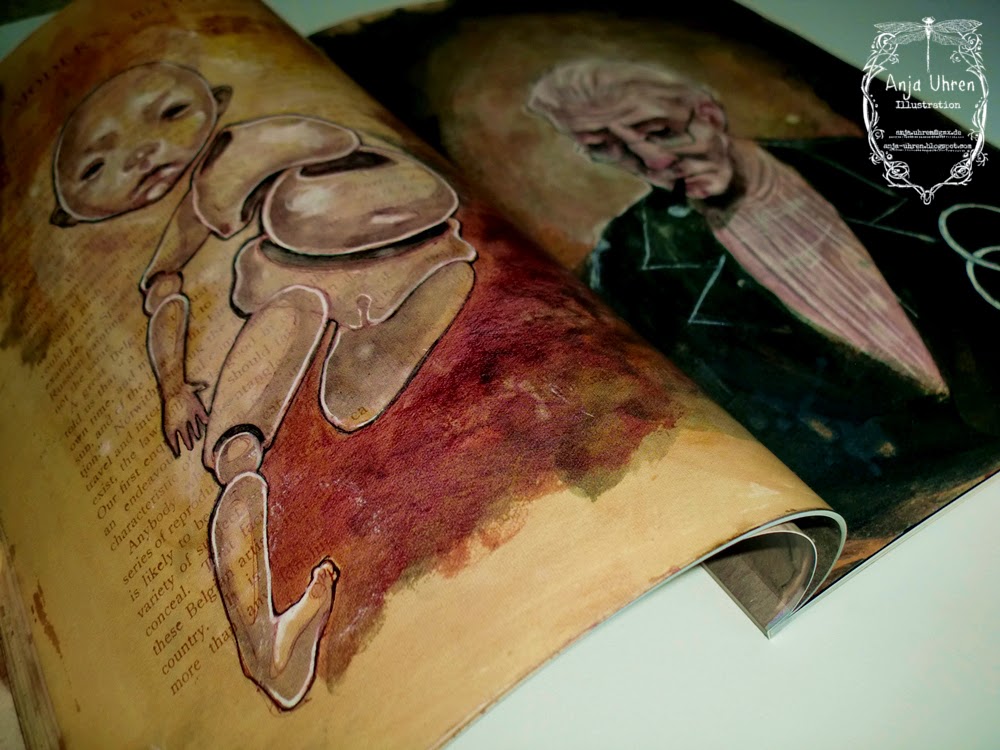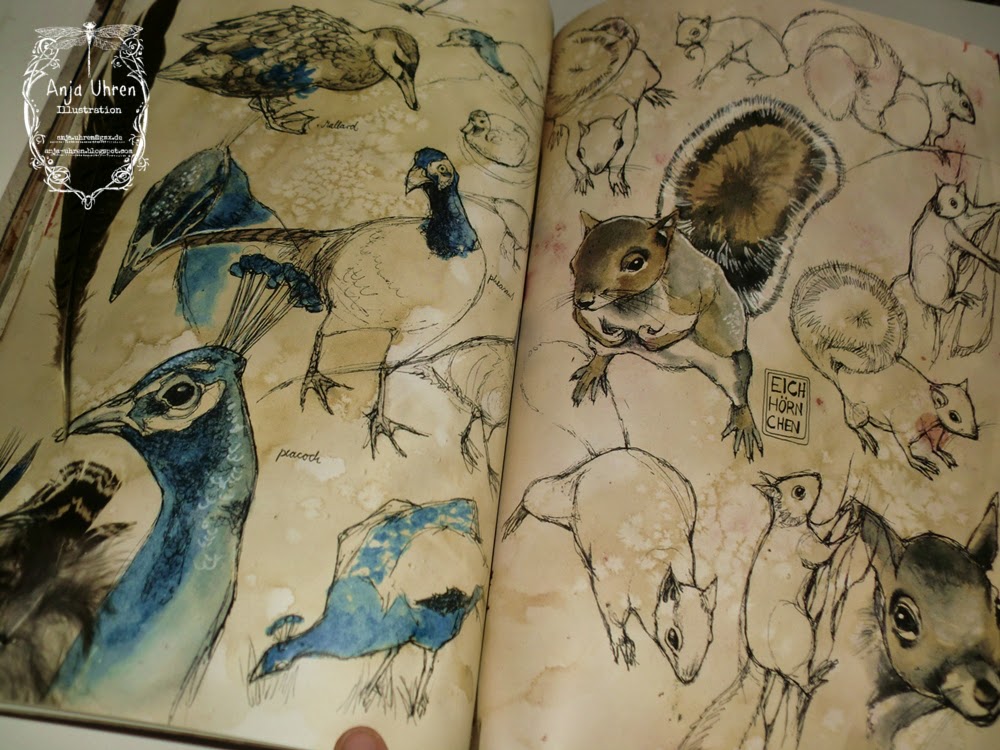Friday 27 June 2014
Tuesday 3 June 2014
Katschawatscha and the Blue Puppy
Hello everyone!
A week ago I received my
printed copy of a children's book I did some illustrations for
earlier this year. I'm very pleased with how the printed German
version of 'Katschawatscha and the Blue Puppy' came out. The
reproduction of the images is outstanding (and it's very hard to
please me when it comes to that!). My only regret would be that it's
a tad too small for my taste but I understand that the author tried
to keep production costs very low to be able to offer it at a
competitive price.
Here are a few
photographs:
As stated earlier this is
only the German version. There is an English one available which
probably varies slightly as the publisher is a different one.
For more information and
to purchase your own digital or printed copy please follow these
links to amazon.co.uk or amazon.de respectively.
Origin
This has been quite a
lenghty project and I'm glad to finally be able to talk about it
here.
Tatana Fedorovna approached me last summer, asking if I would be interested in illustrating her children’s story ‘Katschawatscha and the Blue Puppy’ which is a Magical Russian Fairy Tale Adventure about ‘Brave Dogs, Courageous Knights, Elves, Tartans, a Princess and True Love’ – as the subtitle suggests. I have worked with the Russian-German author before in 2013, illustrating her novel ‘Zarin der Vampire’ (‘Tsarina of the Vampires’) so I was already familiar with her writing. This project was going to be quite different though, as the story was mainly aimed at children.
In her story ‘Katschawatscha’ is the daughter of the infamous Slavic mythology character ‘Baba Jaga’. Her mother strangely disappeared and left her offspring – who is a far cry from being a well educated witch – alone in her bewitched house that stands and walks on two chicken legs. The young witch is full of mischief and on one dull morning decides to dye a puppy bright blue. This is where the story starts. Different lines of action take their course and are all at some point connected through this bewitched blue puppy.
Inspiration
I grew up in Eastern Germany shortly after the
DDR had been dissolved and joined with Western Germany. Books and
films from the former Sowjetunion still played a very big role in
that area and I vividly remember especially Russian stories as part
of my childhood. Some of the old picture books I kept therefore
served as reference material as they perfectly captured the cultural
elements that were useful in realising ‘Katschawatscha and the Blue
Puppy’.
The story itself has its roots in the famous tales
about Baba Jaga but the addition and main focus on Katschawatscha,
the daughter of the famous witch, puts a new spin to the classic
stories and therefore a slightly more contemporary feel. In a similar
way I wanted to use the old picture books to inform fresh
illustrations that would feel rooted in tradition.
Character Design
The first thing I did was
to design the characters. I absolutely love this stage of every
project as it helps greatly to really get my head around the
particular world and its inhabitants I'd like to capture visually.
There is a variety of different characters in 'KatBP' and I tried to
vary their designs according to their personalities and roles within
the story. It was very important to me to give each of them an easily
recognisable silhouette and it was fun to play around with form and
colour schemes.
This is Katschawatscha
- Baba Jaga’s daughter. She is a young witch around 20 years old,
which is exceptionally young for a witch..
She wants to be the talk of the town and prove to everyone that she too is a very special witch, just like her mother.
She wants to be the talk of the town and prove to everyone that she too is a very special witch, just like her mother.
She is not exactly dumb and can read very well.
This is the Blue
Puppy. It was bewitched by
Katschawatscha before his birth to have bright blue furr, as dazzling
as a parrot. He is the seventh puppy of Aljona, Petja’s dog and
because of his strange colour he is an outsider in his family from
the beginning.
Petja plans to drown the poor thing but then feels pity for him and leaves him alone at the river bank. From there we accompany our little friend on his search for a family.
Petja plans to drown the poor thing but then feels pity for him and leaves him alone at the river bank. From there we accompany our little friend on his search for a family.
This is Baba
Jaga - the over 100 year old
infamous witch.
She dissappeared to who knows where and left her only
daughter behind.
She boasts to everyone that the devil himself is her
lover and father of Katschawatscha – which, as a fact, is not at
all true…
This is Petja,
Katschawatscha’s real father. Neither he nor Katschawatscha know
about it though.. The poor drunkard was tricked by Baba Jaga in a
Pokergame.
He lives alone with his dogs and has no family because since his unfortunate encounter with Baba Jaga no woman dares to approach him.
He lives alone with his dogs and has no family because since his unfortunate encounter with Baba Jaga no woman dares to approach him.
Even his friends are dishonest louts that stab him in
the back and so his best friend is the bottle.
He also is the owner of the pregnant dog Aljona..
 |
| The kind King. |
 |
| Wadim - the ancient servant of the King’s father who knows Baba Jaga from earlier years. |
 |
| The lovely Princess. |
Like every real witch Katschawatscha obviously also has a cat. Since she lives in a house on chicken I figured it only makes sense if her cat shares a similar fate. Maybe due to a witchcraft accident…Katschawatscha is not very experienced after all.
He is only mentioned in the text once very briefly
but I am thinking about featuring him on every illustration
Katschawatscha is one. He’ll be doing curious things and the reader
can have some fun looking for him on every image. This is in keeping
with the overall humor of the narrative.
For this one I even created a model out of sculpey.
It's a great tool to create 3 dimensional characters out of your
drawings – they can help you immensely with figuring out their look
from every angle.
I didn't quite manage to finish it though as someone knocked it of the shelf at some point and it now has several cracks and lost all its feet...it was helpful making him nervertheless!
Aljoscha Popovich - the most stereotypical hero of the narrative also based on a character from traditional Russian folklore.
I didn't quite manage to finish it though as someone knocked it of the shelf at some point and it now has several cracks and lost all its feet...it was helpful making him nervertheless!
Aljoscha Popovich - the most stereotypical hero of the narrative also based on a character from traditional Russian folklore.
A mother’s boy at the beginning he is bestowed with the gift of courage and wit by an elf and goes on to rescue the kingdom of Rus from the Tartan Kings and their armies.
He also helps to join the two dogs and marries the
princess in the end.
Aljoscha’s little sister. She’s just a supportive character but very lovely and I greatly enjoy drawing her.
Aljoscha’s little sister. She’s just a supportive character but very lovely and I greatly enjoy drawing her.
 |
The Popovich siblings.
|
Ilja Muromez
of Murom - a veteran warrior with supernatural strength. His
companion is the strong, black mare Karuschka which is able to
talk.
He becomes Aljoscha’s teacher and helper.
He becomes Aljoscha’s teacher and helper.
 |
| The General - a Royal Knight who follows Aljoscha into battle. |
Storyboarding
I then carefully analysed the narrative
structure of the story. I
identified 3 different main plots that intertwine with and influence
each other and each has their own hero which makes it quite an
unusual structure that didn’t match with any of the narrative
theories I tried to apply.
In the heroic saga plot of which Aljoscha is the main character I was able to identify some of Vladimir Propp’s 31 functions but that was about it.
In the heroic saga plot of which Aljoscha is the main character I was able to identify some of Vladimir Propp’s 31 functions but that was about it.
It was very useful however to get an idea of the
exact succession of the events that partly take place at the same
time only at different places. Figuring this out gave me the
opportunity to integrate small details into individual illustrations
that hinted at how the apparently separate plots intertwine.
I then created the storyboard for all required
illustrations and small coloured thumbnails for each of them to give
me a vague idea of the overall colour scheme. These are but a few
examples.
Creating the Final Illustrations
Now all that was left was to create the final
illustrations. I created pencil drawings on water colour paper first,
then applied the first wash of coloured ink over it, sprinkling it
with salt as I went to create some interesting texture and finally I
added multiple layers of acrylic paint, coloured ink and coloured
pencil on top to create depths and vibrancy. I've been using really
bright colours for this project which was a bit of a challenge as I
usually prefer muted hues but it was a good experience and I feel
much more comfortable in the use of colour overall now.
Here are a few work in progress and final images.
If you'd like to see all of them in their full glory
I do recommend to buy the book. :)
Also some of the A3 sized original illustrations are
now up for sale in my Etsy shop. Go and have a look if you're
interested. :)
I do hope this post gave you a small insight into my journey of creating these illustrations. :)
I do hope this post gave you a small insight into my journey of creating these illustrations. :)
All the best,
Anja
Subscribe to:
Posts (Atom)






























































































